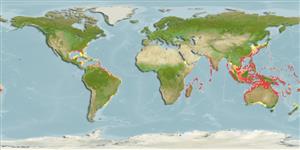Bryopsidophyceae |
Bryopsidales |
Caulerpaceae
Environment: milieu / climate zone / depth range / distribution range
Ecology
Sessile; depth range 0 - 79 m (Ref. 102098). Tropical
Atlantic and Indo-Pacific oceans.
Length at first maturity / Size / Weight / Age
Maturity: Lm ? range ? - ? cm
Thallus consists of a horizontal branched stolon and erect shortly stipitate blades, 4 to 10 times longer than broad. Apices of blades slightly rounded, emarginate, rarely truncate; the margins often finely to coarsely dentate in their entire length or limited to some parts of the blade; blade unbranched or branched, branching occurs near the base of the blades. Thalli attached to sandy-muddy substrate by a rhizoidal holdfast. Erect blades up to 3 cm in height (Ref. 80758).
Used for human consumption as food and medicine: antifungal, lowers blood pressure (Ref. 80758). Grows on sand flats or on sandy bottoms with coral rocks, or in tide pools at the open coast (Ref. 80758).
Life cycle and mating behavior
Maturity | Reproduction | Spawning | Eggs | Fecundity | Larvae
Guiry, M.D. and G.M. Guiry 2009 AlgaeBase. World-wide electronic publication, National University of Ireland, Galway. http://www.algaebase.org; searched on 14 April 2009. (Ref. 80701)
IUCN Red List Status
(Ref. 130435: Version 2025-1)
CITES status (Ref. 108899)
Not Evaluated
Not Evaluated
Threat to humans
Human uses
Fisheries: commercial
| FishSource |
Tools
More information
Trophic EcologyFood items (preys)
Diet composition
Food consumption
Predators
Population dynamicsGrowth
Max. ages / sizes
Length-weight rel.
Length-length rel.
Length-frequencies
Mass conversion
Abundance
Life cycleReproduction
Maturity
Fecundity
Spawning
Eggs
Egg development
Larvae
PhysiologyOxygen consumption
Human RelatedStamps, coins, misc.
Internet sources
Estimates based on models
Preferred temperature
(Ref.
115969): 23.3 - 28.8, mean 27.3 (based on 774 cells).
